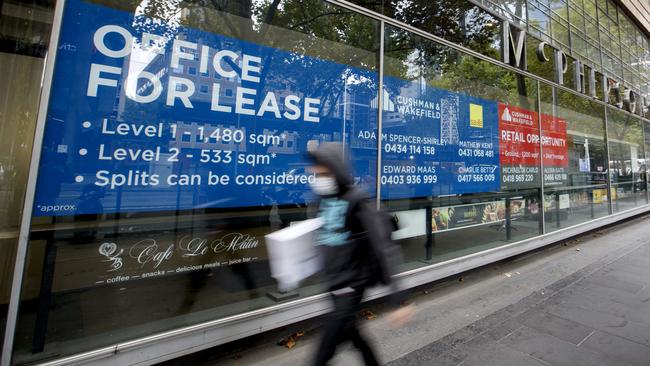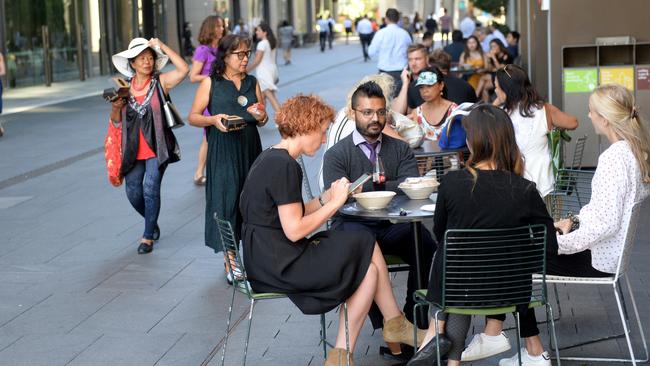Australia’s CBDs could take years to recover as shoppers, workers and tourists stay away


The situation is particularly bad in lockdown-hit Melbourne where Lord Mayor Sally Capp told the Australian Retailers Association’s Leaders Forum on Wednesday that 20 per cent of retail stores were closed temporarily or permanently and 47 per cent of the shopfronts in the Docklands area were empty.
The shaky state of CBD retail was a key discussion point during the forum with the chief executive of the Brand Collective, Caleb Brown, calling on Capp to consider offers of temporary free parking to encourage people to venture back into the CBD.
Brown argued that some stimulatory measures and special events were needed to encourage more people to venture back into the CBD shopping areas.
The situation around Australia varies with Melbourne by far the hardest hit given the months of lockdowns last year and snap lockdowns this year.
Over time, if people are discouraged from leaving home for months on end, they get out of the habit of going to the office with many finding it hard to lose a fear of travelling on crowded public transport having been told for so long that it is risky.
And there is no sign of the overseas tourists who always brightened up the CBDs being able to return any time soon.
Recent figures from the Property Council show that only 24 per cent of offices in Melbourne were occupied in February compared to 48 per cent in Sydney, 64 per cent in Brisbane, 69 per cent in Adelaide, and 65 per cent in Perth and Canberra.
The most thriving CBD is in Darwin which is back to 80 per cent occupancy, followed by Hobart at 76 per cent.
But with the country’s two major business capitals down to below 50 per cent occupancy, retail in the city centres is hurting with some businesses on the brink of collapse.
Property Council CEO Ken Morrison said recently that there was still a long way to go before the country’s big commercial centres were back to normal.
“It is clear that snap lockdowns have had an impact on CBD workers’ ability to return to their offices and their confidence to do so,” he said. “While we’re all expecting to see more people working from home as part of the post-COVID normal, thriving CBDs will be critical to Australia’s economic recovery.”
The big fear for Melbourne is the end of JobKeeper at the end of the month which could see some smaller shops and businesses which have been hanging on by their fingernails finally deciding to close.

ARA chief executive Paul Zahra said he feared that April would see the start of a wave of administrations as CBD retailers find they can no longer afford to keep their doors open.
“CBD retail is in a distressed state,” he said.
“We are already seeing a lot of livelihoods at risk and companies shedding jobs in CBDs.”
He said some were predicting it could take as long as a decade before the Melbourne CBD retail to return to pre-COVID levels.
Estimates were that it would take Sydney five years to get back to pre-COVID levels with Brisbane looking at three years to get back to “normal”.
While one could argue that retail dollars not spent in CBDs were being spent in the suburbs, Zahra pointed out that many retail chains and businesses work on a franchise basis — so a franchisee in a CBD might well not benefit from an uptick in spending in the suburbs.
It also meant big department stores were being underused.
With the emergence of a hybrid working model of employees working partly from home and partly in the office, the next wave would be decisions by big employers to let go floors upon floors of office space.
While the Morrison government has been eager to point out how well the economy has recovered, there are very much winners and losers in post-COVID with online shopping one of the winners and CBD and travel-related retail clear losers.
Overall, retail has benefited from the closing of the borders which has seen the $60bn that Australians spend to travel overseas each year now being spent at home, which is translating into good business for big retailers like Coles, Woolworths, Aldi and Metcash, as well as homeware stores Harvey Norman and JB Hi-Fi and online retailers such as Temple & Webster.
But retail and property in CBD areas could take years to recover incurring some more permanent scars.
As Sally Capp told the forum, staging events is one way of getting people to start venturing back into CBDs.
The opening of Hamilton in Sydney and the reopening of Harry Potter in Melbourne are signs of life returning to CBDs which could play important roles in encouraging people to venture out of the suburbs.
She said Melbourne Fashion Week, which is on now, was playing a role.
Zahra would like to see special assistance programs for CBD retailers.
Caleb Brown pointed to the extortionately high cost of parking in some CBD areas, suggesting that three month free or cheap parking, in Melbourne in particular, could help steady the ship during the rocky weeks ahead.
Yes Australia has done pretty well a year on from the onset of COVID but against the winners there are some big losers whose fate is set to get more precarious at the end of this month.







While sales have held up exceptionally well during the past year, retail trade in Australia’s CBDs continues to be depressed by stay at home office workers, shoppers not wanting to catch public transport and a lack of international tourists.